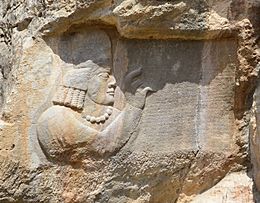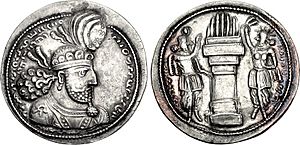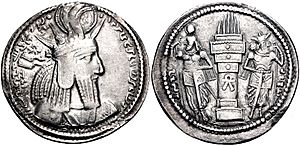Kartir facts for kids
Quick facts for kids
Kartir
|
|
|---|---|

Kartir's inscription at Naqsh-e Rajab
|
|
| Born | 3rd century |
| Died | 3rd century Iran
|
Kartir (also spelled Karder or Kerdir) was a very powerful and important Zoroastrian priest. He lived in ancient Iran during the 3rd century AD. This was the time of the Sasanian Empire. Kartir served four different Sasanian kings. These kings were Shapur I, Hormizd I, Bahram I, and Bahram II.
His name is found in many old inscriptions. These are like ancient stone writings. They tell us about his journey to power. Kartir helped shape the religion and laws of the Sasanian Empire. Later, he supported Narseh to become king. After Narseh took the throne, Kartir's influence slowly faded away.
Contents
What's in a Name?
Kartir's name was written in several ways in ancient texts. For example, in Middle Persian, it could be Kardīr. In Parthian, it was Krtyr. The Greeks spelled it Karteir. Even in Coptic, it was Kardel. This shows how widely known he was. His name also appeared in other parts of the Iranian world.
Kartir's Journey to Power
Serving King Shapur I

Kartir first appears in historical records around 260 to 262 AD. This was during the reign of Shapur I. Shapur I was known for being tolerant of different religions. He admired Zoroastrianism. But he also allowed Jews, Christians, Buddhists, and Hindus to practice their faiths freely.
Shapur I was also friendly with Mani. Mani was the founder of a religion called Manichaeism. Shapur I even let Mani preach his ideas freely. He allowed Mani to join him on military trips. Kartir, however, had different ideas about religion. He wanted Zoroastrianism to be the main religion.
Under King Hormizd I
When Shapur I died in 270 AD, his son Hormizd I became king. Hormizd I recognized Kartir's importance. He gave Kartir special clothes worn by the upper class. He also appointed Kartir as the chief priest, known as the mowbed. This was a very high position.
Hormizd I ruled for only one year. After him, Bahram I became king. Kartir's power and influence grew even more during this time. He helped Bahram I become king. Bahram I then made an agreement with his brother Narseh. Narseh gave up his claim to the throne. In return, he became the governor of Armenia. This was an important border area.
Under King Bahram I
Before Bahram I, Sasanian kings often allowed different religions. But with Bahram I as king, things changed. Kartir's influence as a Zoroastrian priest grew stronger. When Mani, the founder of Manichaeism, came to the city of Gundishapur, there was a lot of trouble.
Kartir and other Zoroastrian priests protested against Mani. They convinced Bahram I to imprison Mani. Mani was sentenced to death in 274 AD. After Mani's death, Kartir and the Zoroastrian clergy began to persecute Mani's followers. They also targeted other religious groups. They did this to spread their own influence.
Kartir saw Mani's ideas as a threat. He believed Mani was mixing Zoroastrianism with other religions. With King Bahram I's support, Kartir started to build a strong Zoroastrian state church. Because of this, Bahram I was seen as a "good and worthy king" in Sasanian writings. Bahram I's son, Bahram II, became the next king. Kartir might have helped Bahram II get the throne instead of Narseh. This likely made Narseh very unhappy.
Under Kings Bahram II, Bahram III, and Narseh
King Bahram II also welcomed Kartir. He saw Kartir as a mentor. Bahram II gave Kartir many honors. He made him a grandee, a high-ranking noble. Kartir was also appointed the supreme judge of the entire empire. This meant that priests now held important legal positions. Kartir also became the manager of the Anahid fire-temple at Istakhr. This temple was originally managed by the royal family.
Under Bahram II, Kartir became very powerful. He claimed in his inscriptions that he "struck down" non-Zoroastrian groups. These included Christians, Jews, Mandaeans, Manichaeans, and Buddhists. However, some historians say it's not clear how much of this actually happened. For example, Jewish and Christian writings from that time do not mention persecutions.
Bahram II died in 293 AD. His son, Bahram III, became king. But Bahram III ruled for only four months. Many Iranian nobles did not support him. They called Narseh to Mesopotamia. Kartir was one of the nobles who supported Narseh. This is recorded in the Paikuli inscription. Narseh became the new king.
Narseh's rule brought back the policy of religious tolerance. This was similar to what his father, Shapur I, had done. Under Narseh, Kartir's influence decreased. He is not mentioned doing anything very important as high priest during Narseh's reign.
Kartir's Legacy
Historians have different views on Kartir. Some see him as a very strict religious leader. They describe him as a "ruthless fanatic" who promoted a state religion. Others have a more positive view. They see him as a "spiritual man" who wanted religious truth to be known to everyone. Some also note that the Sasanian government supported Kartir's plans. He was certainly a very important and influential figure in ancient Iranian history.
See also
 In Spanish: Kartir para niños
In Spanish: Kartir para niños
- Kartir's inscription at Naqsh-e Rajab





